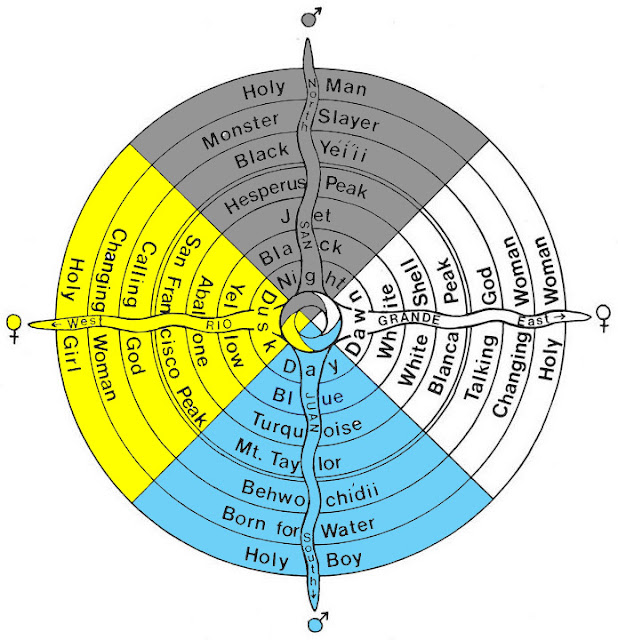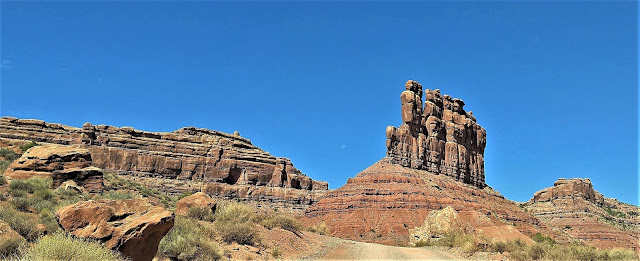John Sawhill
 |
Mexican
Hat with Raplee Ridge as gorgeous backdrop |
To and from Monument Valley, and near a well-travelled road is Mexican Hat, a curious rock formation sometimes referred to as the ‘Sombrero’, or the ‘Pancake’. Behind it, though, is a much more intriguing cliff known as Raplee Ridge where, over eons, runoffs have cut deep gullies in alternating layers of gray gypsum, salt, and red sedimentary rock, resulting in scarlet and drab orderly zigzags.
 |
Very
grainy picture from too far away but zigzags are easily visible |
Raplee Ridge, Utah
Raplee Ridge Rug (by the locals) is a very interesting eight-mile-long formation that is known a monocline with a succession of anticlines and synclines. A monocline is a step-like fold in rock strata consisting of a zone of steeper dip within an otherwise horizontal or gently-dipping sequence. An anticline is a type of fold that is an arch-like shape and has its oldest beds at its core. A typical anticline is convex up in which the hinge or crest is the location where the curvature is greatest, and the limbs are the sides of the fold that dip away from the hinge. A syncline is the inverse of an anticline.
 |
Monocline,
more like a step than a valley or a ridge |
 |
Monocline
– all leaning to the left |
 |
Middle
left, peek of the San Juan River. A bit above that is Mexican Hat |
 |
Monocline
at Sunset, 2021 |
Zigzags ‘woven’ by erosion may have been the inspiration of Navajo weavings.
 |
Can
you see the resemblance? |
Mexican Hat, Utah
One of Utah’s strangest rock formations, balances a flattened UFO-like-pancake-disk atop a 300-foot-high talus cone. It’s similar to a sombrero with a wide brim jutting above a narrow neck. It is a caprock of sandstone over a pedestal and talus cone of red shale and siltstone, dating from the Permian Period, over 250 million years ago.
I wasn’t equipped to climb it but spider-like agile folks have done so for a long time. From some accounts, left on top of the hat is supposedly a Coke bottle with a Bill Forrest business card inside as well as a picture from a biker magazine of a buxom topless female on a black Harley… Seems befitting of this oddly shape formation.
 |
| Mexican Hat, different view |
The Four Worlds of the Diné
(Navajo People)
 |
Photo
by New Mexico photographer, Daniel Zuni |
Diné
origin stories begin with a First World of darkness. From this Dark World the Diné
began a journey of emergence into the world of the present. It had four
corners, and over these appeared four clouds. These four clouds contained
within themselves the elements of the First World.
 |
Four
sacred mountain locations Cartography
by Ulhor |
The Holy People put four sacred mountains in four different directions, Mt. Blanca to the east, Mt. Taylor to the south, San Francisco Peak to the west and Mt. Hesperus to the north, thus creating Navajoland. The four directions are represented by four colors: White Shell represents the east, Turquoise the south, Yellow Abalone the west, and Jet Black the north.
The number four permeates traditional Diné philosophy. In the Diné culture there are four directions, four seasons, the first four clans and four colors that are associated with the four sacred mountains. In most Diné rituals there are four songs and multiples thereof, as well as Diné wedding basket and many other symbolic uses of four.
 |
Diné Rainbow Boy Chant |
Diné
silversmiths, can use the four precious stones and shells to connect their work
to Diné beliefs. Diné sand paintings are both an art form and a means of a
spiritual communication that makes use of the sacred colors to transmit
information about culture. Weaving is another important Diné art form, and Diné
weavers choose colors based on both aesthetic appeal and cultural symbolism.
First / Black World or Ni’hodilhil:
The beginning of time. In the First World, there lived various spiritual
beings. They were given Diné names describing certain insects and animals.
Altse Hastiin (First Man) and Altse Asdzaa (First Woman) were created. The
beings couldn’t get along with one another so they decided to leave through an
opening in the east into the Second World. It is associated with the North,
nighttime, and jet black stones.
Second
/ Blue World or Ni’hodootl’izh: This world was already
occupied by the Blue Birds, animals and other beings who were in disagreement
and couldn’t get along with one another. There was severe hardship so they
decided to leave this world. First Man made a wand of white shell, turquoise,
abalone, and jet. This wand carried everyone through an opening in the south
into the Third World. It is associated with the South, daytime, and turquoise.
Third / Yellow World or
Ni’haltsoh: This world was entered first by Bluebird,
First Man, First Woman, Coyote, and other beings. This land had great rivers
crossing from east to west and north to south. One day, Coyote stole Water Baby
from the river, causing a great flood. First Man ordered everyone to climb into
the reed to escape the rising waters. As the beings climbed out of the reed
into the Fourth World, the people discovered Coyote was the one who had stolen
Water Baby. Coyote took the Water Baby back to its mother and the flooded
waters began to recede. It is associated with the West, dusk, and abalone
shells.
Fourth / White or
Glittering World or Ni’halgai (today’s world):
Locust was the first to enter the fourth world. He saw water everywhere and
other beings living there. The beings in the Fourth World would not let the
beings from the Third World to enter unless the Locust passed certain tests.
Locust passed all the tests and the people entered into the Fourth World.
Later, First Man and First Woman formed the four sacred mountains. The sacred
dirt was brought from the First World to form these mountains. It is associated
with the East, dawn, and white shells.
 |
Another
version of the four colors |
The Diné use the four colors in ways too numerous to list, and their meanings are frequently subtle and complex. The colors’ symbolism connects the past, present, and the future of the Diné people. It interweaves geography, spirituality, and art and encodes deep meanings into the material culture of the Diné. Using these colors and teaching their meanings to younger generations is one important way the Navajos are preserving their traditional culture.
Valley of the Gods
 |
I
may be wrong but I believe this one is called The Seven Sailors |
I will end with just a
few pictures of the Valley of the Gods. An area just north of Monument Valley
but free to drive through and explore. I don’t actually know the names of most
of the various formations I saw but it was another beautiful place to visit.
 |
Very
faint moon in an incredibly blue sky |
 |
One
can camp here surrounded by this amazing panorama |
The four corner area of the US is a paradise for geologists and nature lovers. It is, however, still quite wild and remote. One cannot expect all the comforts of glamping, so not for everyone.
Next up, The San Rafael Swell, The Little Grand Canyon, and Goblin Valley State Park.




No comments:
Post a Comment
We are always happy to hear from you but at times it may take a while to get a reply - all depends if we have access to the internet.